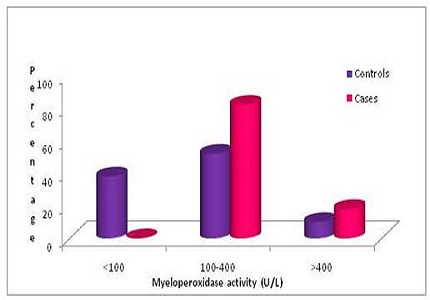Correlation between lipid profile and myeloperoxidase levels in type-2 diabetes mellitus
Abstract
Introduction: Diabetes mellitus is the most common endocrine disorder caused by absolute or relative deficiency of insulin. Chronic hyperglycemia and enhanced oxidative stress have been implicated in the pathogenesis of diabetic vascular complications. These patients are more prone to adverse cardiovascular events which occur due to the accelerated rate of atherosclerosis in diabetic patients. Myeloperoxidase apart from playing a major role in innate immunity has been implicated in the various stages of atherosclerosis namely initiation, progression and plaque rupture. The objective of the study was to estimate the plasma myeloperoxidase activity in type-2 diabetics and to establish a correlation between plasma myeloperoxidase activity and lipid profile and glycated haemoglobin (HbA1c) in the study population.
Methods: Plasma myeloperoxidase activity was estimated by spectrophotometric method using O-dianisidine dihydrochloride as substrate. Lipid profiles, HbA1c and blood sugar was analysed in an auto- analyser.
Results: There was a statistically significant increase in plasma myeloperoxidase activity in diabetic patients when compared with non-diabetic individuals (p<0.001). There is a significant positive correlation between plasma myeloperoxidase activity and serum triglyceride levels in the study population (p < 0.001).
Conclusion: Plasma MPO activity was significantly higher in the diabetic patients when compared with non-diabetic controls. There is significant positive correlation between MPO activity and serum triglyceride levels.
Downloads
References
2. Hartge MM, Unger T, Kintscher U. The endothelium and vascular inflammation in diabetes. Diabetes and Vascular Disease Research. 2007 Jun 1;4(2):84-8. [PubMed]
3. Klebanoff SJ. Myeloperoxidase: friend and foe. Journal of leukocyte biology. 2005 May 1;77(5):598-625. [PubMed]
4. Nicholls SJ, Hazen SL. Myeloperoxidase, modified lipoproteins, and atherogenesis. Journal of lipid research. 2009 Apr 1;50(Supplement):S346-51. [PubMed]
5. Vaisar T, Shao B, Green PS, Oda MN, Oram JF, Heinecke JW. Myeloperoxidase and inflammatory proteins: pathways for generating dysfunctional high-density lipoprotein in humans. Current atherosclerosis reports. 2007 Nov 1;9(5):417-24.
6. Böker T, Augustin AJ, Breipohl W, Spitznas M, Lutz J. Increased lipid peroxide level and myeloperoxidase activity in the vitreous of patients suffering from proliferative vitreoretinopathy. Graefe's archive for clinical and experimental ophthalmology. 1994 Nov 1;232(11):652-6.
7. Sato N, Shimizu H, Suwa K, Shimomura Y, Kobayashi I, Mori M. MPO activity and generation of active O2 species in leukocytes from poorly controlled diabetic patients. Diabetes Care. 1992 Aug 1;15(8):1050-2.
8. Shetty S, Kumari SN, Madhu LN. Variations in Serum Myeloperoxidase Levels With Respect To Hyperglycemia, Duration of Diabetes, BMI, Sex And Aging in Type 2 Diabetes Mellitus. Int J Res Pharm Biomed Sci. 2012 Apr;3(2):652-5.
9. Bradley PP, Priebat DA, Christensen RD, Rothstein G. Measurement of cutaneous inflammation: estimation of neutrophil content with an enzyme marker. Journal of Investigative Dermatology. 1982 Mar 31;78(3):206-9.
10. Wiersma JJ, Meuwese MC, van Miert JN, Kastelein A, Tijssen JG, Piek JJ, Trip MD. Diabetes mellitus type 2 is associated with higher levels of myeloperoxidase. Medical science monitor. 2008 Aug 1;14(8):CR406-10.
11. Zhang C, Yang J, Jennings LK. Leukocyte-derived myeloperoxidase amplifies high-glucose—induced endothelial dysfunction through interaction with high-glucose—stimulated, vascular non—leukocyte-derived reactive oxygen species. Diabetes. 2004 Nov 1;53(11):2950-9.
12. Olza J, Aguilera CM, Gil-Campos M, Leis R, Bueno G, Martínez-Jiménez MD, Valle M, Cañete R, Tojo R, Moreno LA, Gil A. Myeloperoxidase is an early biomarker of inflammation and cardiovascular risk in prepubertal obese children. Diabetes care. 2012 Nov 1;35(11):2373-6.
13. Moldoveanu E, Tanaseanu C, Tanaseanu S, Kosaka T, Manea G, Marta DS, Popescu LM. Plasma markers of endothelial dysfunction in type 2 diabetics. European journal of internal medicine. 2006 Jan 31;17(1):38-42.
14. Sarwar N, Danesh J, Eiriksdottir G, Sigurdsson G, Wareham N, Bingham S, Boekholdt SM, Khaw KT, Gudnason V. Triglycerides and the risk of coronary heart disease 10 158 incident cases among 262 525 participants in 29 western prospective studies. Circulation. 2007 Jan 30;115(4):450-8.



 OAI - Open Archives Initiative
OAI - Open Archives Initiative


